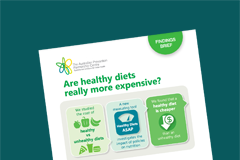Are healthy diets really more expensive?
We studied the cost of healthy versus unhealthy diets and developed a new measuring tool, Healthy Diets ASAP, to investigate the impact of nutrition policies. Download our Findings Brief for a summary of the key findings and relevance for policy and practice.
Key messages
- Poor diet is a leading cause of preventable disease in Australia and around the world.
- The public perception that healthy foods are expensive is believed to be a barrier to improving diets.
- Before this study, the price of (recommended) healthy diets and unhealthy (current) diets had not been compared in the real world.
- This study showed that healthy diets would be 12–15% cheaper than unhealthy diets for a family of two adults and two children.
- Households in all socioeconomic areas spend more on unhealthy food and drink choices (around 58% of the food budget) than on healthy food and drinks.
- Healthy food already costs low-income households up to around one-third (31%) of their disposable income. A healthy diet would become unaffordable for low-income households if the GST base was expanded to include basic healthy foods.
- The project has developed the Healthy Diets ASAP (Australian Standardised Affordability and Pricing) methods, which can be used to investigate the real-world impact of fiscal policy actions in Australia, such as a tax on sugary drinks.
